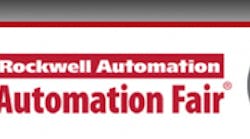Visitors to the Automation Fair exhibit hall this week at Houston’s George R. Brown Convention Center can peer into the not-too-distant future at the “Innovations” booth. An exclusive look at forward-thinking technologies on the verge of release, the Rockwell Automation exhibit showcases the next generation of industrial automation.
“All other booths show products that are available,” explained John Pritchard, manager, strategic business development, Rockwell Automation. “This is where we share with customers technologies that are works in progress. We want to share those developments before they’re mature, so customers can see the direction we’re headed. And we want to get feedback about those technologies.”
[sidebar id =1]
The booth originated three years ago and has seen many of its displays go on to become successful Rockwell Automation solutions. This year’s booth is demonstrating technology that spans the application gamut, from design and analytics to display and mobility. “We’re showing technologies involved in the design process,” said Pritchard. “We’re showing technologies around analytics and how they can scale. We’re showing technologies around how information shows up, including mixed reality. And we’re addressing the increased use of mobility in the manufacturing environment.”
New design technology on display involves information already available in Rockwell Automation’s Studio 5000 Application Code Manager, where machine builder libraries include information such as machine state, events, consumption rates and runtime odometers. “Customers have always been able to get to that information. But this is like a catalyst because we’ve eliminated all of the manual work to get at that data. It can be used on-premise or shot up to the cloud,” said Pritchard. “This is big news for control design engineers.”
Analytics on parade
Analytics is also focus of Rockwell Automation’s development efforts, and examples abound in the Innovations booth. “We’re showing a new technology called servo-motor analytics,” said Pritchard. “Our engineers have designed and embedded sensing technology into the servo motor itself and then worked with data scientists to look at and understand the signatures the sensors pick up.”
Based on data gathered from 3D accelerometers, the analytics are able to tell whether the servo motor is experiencing an offset load, detect anomalies in timing-belt tension, and alert if the motor is experiencing bearing wear.
“The timing-belt tension is a real chestnut,” said Pritchard. “It’s especially useful to know during setup that you’ve set the tension correctly,”
“We showed predictive analytics for the first time last year,” explained Pritchard. “The predictive analytics run locally to a controller and are able to monitor control variables. You teach it what good looks like and what bad looks like.” With a bit of experience and fuzzy logic, the analytics are able to identify bad before it occurs. It’s able to spot pump cavitation, for example, before it happens and initiate appropriate corrective action.
Designed to be fully scalable, the analytics can run at the device level—on an option card in a PowerFlex drive, for example—on a local industrial computer or back at an industrial data center (IDC). “Here, it’s running on the CompactLogix 5480,” said Pritchard,” but the core analytics function can be deployed at a system or device level.”
When Automation Control Products (ACP) was acquired by Rockwell Automation in September 2016, its ThinManager technology provided a viable means to deliver information to a variety of displays, from laptops to tablets to phones. “Now, we’re working on relevance, meaning displays can be tailored so different information shows up to different people by location.”
Those displays can even include Microsoft HoloLens mixed reality headsets (photo). Because the HoloLens runs Windows 10 IoT—a “skinny” implementation of Windows 10—it can run a range of Windows-based applications, including universal ThinClient Manager (UTCM) interfaces into “heavier” applications hosted elsewhere. In the mixed-reality environment, the wearer simply needs to look at or above a machine or device to see relevant information floating above it in a virtual machine dashboard.
Finally, the TeamONE application environment for mobile devices is showcasing some new modules in the Innovation booth. “We’ve got a Festo module and a connected production module, as well as a module for the servo-motor analytics,” said Pritchard. “You can use any of these to send information and alerts to the TeamONE application on your mobile device.”




